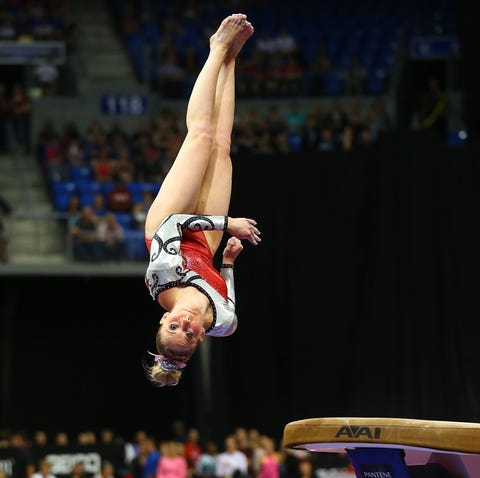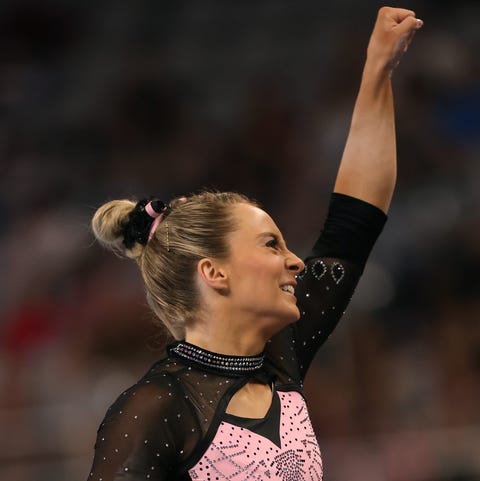In 2016, gymnast MyKayla Skinner placed fourth in the all-around at the Olympic trials, the highest finisher not named to that year’s Olympic team. She was one of three alternates at the Rio Games, where she cheered on her teammates Simone Biles, Aly Raisman, and Laurie Hernandez from the sidelines. “I had come so close to living out my lifelong dream of winning gold,” Skinner says, “and in that moment I realized I couldn’t give up just yet.”
Now, at age 24, Skinner is fighting one final time for a spot on the Olympic team. If she makes it, she will become the oldest female U.S. Olympic gymnast since 2004. Ahead of trials on June 24, the master vaulter opens up about her long journey to Tokyo (including overcoming a foot injury and a positive COVID test)—and how she keeps her “head in the game.”
I was driving to the gym last year when my husband called and broke the news: “The Olympics have been postponed.” I almost swerved into oncoming traffic.
I’m 24, which I know doesn’t sound very old. But in the world of gymnastics it is. The Tokyo Games are my last shot to compete as a gymnast for Team USA, and my last shot at winning a gold medal. “How could this be happening?” I though to myself. Everything I’d worked so hard for, and for so many years, seemed to be falling apart in front of me. I was so pissed off that I actually had a really good practice that day—fueled, I think, by my anger.
At first I saw the silver linings. An extra year might be good to polish up my skills. But in that time, I’ve injured my foot, tested positive for COVID, and spent some time in the hospital recovering from pneumonia. I’m feeling stressed ahead of Olympic trials. I know it’s going to be hard, but I’ve already come so far. I have to push through a little big longer.
I knew I would try for the Tokyo Olympics back in 2016. I was sitting in the stands as an alternate at the Rio Olympics, watching my teammates compete and thinking to myself, “That could have been me.” I had come so close to living out my lifelong dream of winning gold, and in that moment I realized I couldn’t give up just yet.
After Rio, I joined the gymnastics team at the University of Utah. It was a hard transition, because I’ve always competed in elite gymnastics, where we throw big skills. In college, you don’t get any points for difficulty, but once I got the hang of it, it was a piece of cake. It was in college where I rediscovered my love for the sport after everything I went through as an elite gymnast.
My first foray into elite gymnastics was at 13 years old, when I got invited to a national team training camp at “the ranch” with Olympians Shawn Johnson and Nastia Liukin. [Editor’s note: The “ranch” is the former U.S. women’s gymnastics national team training center slash home of former gymnastics coaches Bela and Martha Karolyi in Texas].
It was not what I expected. We weren’t treated the way a group of some of the best athletes in the world should be treated. We had to be perfect at all times, which doesn’t make sense because in gymnastics you need to fail and make mistakes to get better. But if you fell at camp, the reaction was, “We don’t want you anymore.” It made me hate gymnastics, but it’s just what you did if you wanted to be on the Olympic team.
When Larry Nassar was at camp and a girl got hurt, he would take them into the training room, close the blinds, and shut the door. It was strange, but I never thought much about it because he was super nice and so good at what he did. It wasn’t until Worlds in 2014 that it got really weird. He knocked on the door of the hotel room where Madison [Kocian, the two-time 2016 Olympic medalist] and I were staying, and scurried inside. Then he paced back and forth, before handing us ice cream cones and leaving.
Two years later, Steve Penny [the former USA Gymnastics president] brought a group of us gymnasts into a room together, and said, “There’s stuff going on right now, and it’s not looking very good for us. Don’t go around saying anything.” The news about Larry broke a couple months later. I guess it made sense in retrospect, but it was still hard to comprehend because nothing ever happened to me. I was sad that I didn’t know. I wish I could have helped or been there for my friends. Thinking about it today still makes me sick to my stomach.
This content is imported from Instagram. You may be able to find the same content in another format, or you may be able to find more information, at their web site.
I hate that things had to get so bad before they could get better. Now when we go to camp, there’s lots of security. It seems like the organization is genuinely trying to help us by seeing what works and what doesn’t work. As of right now, I feel like it’s going pretty well. And not just in terms of the Larry stuff, but also with how the Olympic team is picked and how coaches interact with the athletes.
Tom [Forster, Team USA’s new high-performance team coordinator] actually talks to us. He’s like, “If you guys have an issue, please come to me.” There’s still a lot of work to be done, and it’s going to take a while for everything to get it to where it needs to be, but it’s moving in the right direction.
After the pandemic hit, my gym remained partially open and I continued to train. I don’t know if it was stress from the Olympic postponement, but my foot got really irritated. That’s when doctors discovered a huge bone spur on the back of my foot. Surgery was out of the question, because I would not have recovered in time for the Olympics. Instead, my doctor suggested a PRP [platelet-rich plasma] injection and rehab. When I wake up in the morning, my feet are stiff, and it can hurt to walk.
It was always going to be a long road to the Olympics, but I never anticipated just how difficult it would become. About a week after my birthday last December, I tested positive for COVID. I’m usually high energy and super crazy. But all I wanted to do was lay around.
This content is imported from Instagram. You may be able to find the same content in another format, or you may be able to find more information, at their web site.
I tried working out at the gym, but had to leave because I didn’t feel well. I did a little more each day, but pushed my body too much. My chest felt stiff and weird, which I thought was a lingering symptom of COVID, but actually turned out to be pneumonia. All I could think about in the hospital was: “How am I supposed to be ready for the Olympics if I have no endurance?” I called my sister crying, and told her, “I’m so behind.”
I was out of the gym for a little over a month in total. For a gymnast, that’s a lifetime. It has definitely set me back, which sucks. But it did give me extra time for my foot to heal. Right now I’m training in the gym for five and a half hours every day, with Wednesdays and Sundays off. I also go to a trainer twice a week, and physical therapy twice a week.
With Olympic trials coming up, I’m just trying to keep my head in the game. I tell myself, “no regrets.” Whatever happens is meant to be. If I wasn’t good enough, I wouldn’t be here. I’ve got this. I have the experience, and I’m a competitor. This is what I’m here to do. I wouldn’t want this to be easy, because if it was I wouldn’t want it so bad. There’s going to be a lot of blood, sweat, blood, and tears, but that’s the fun part.
This interview has been edited and condensed for clarity.
To learn more about all the Olympic hopefuls, visit TeamUSA.org. The Tokyo Olympics begin July 23rd on NBC.
This content is created and maintained by a third party, and imported onto this page to help users provide their email addresses. You may be able to find more information about this and similar content at piano.io





